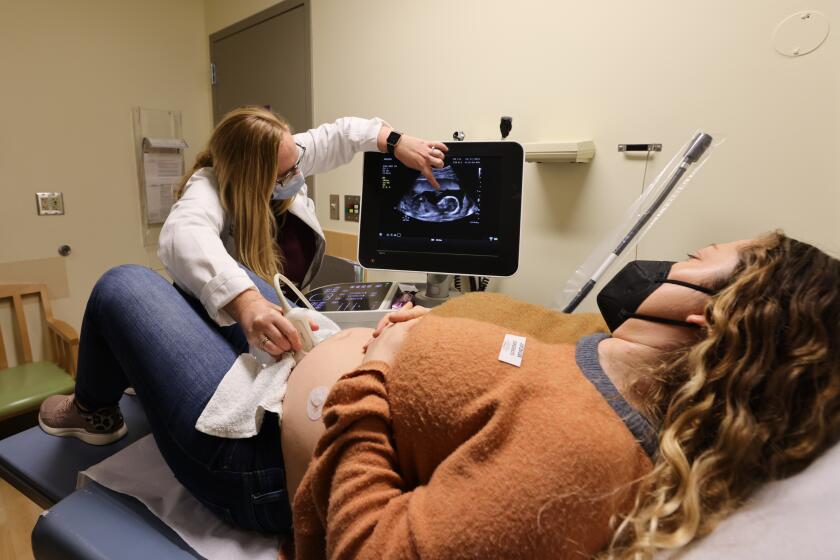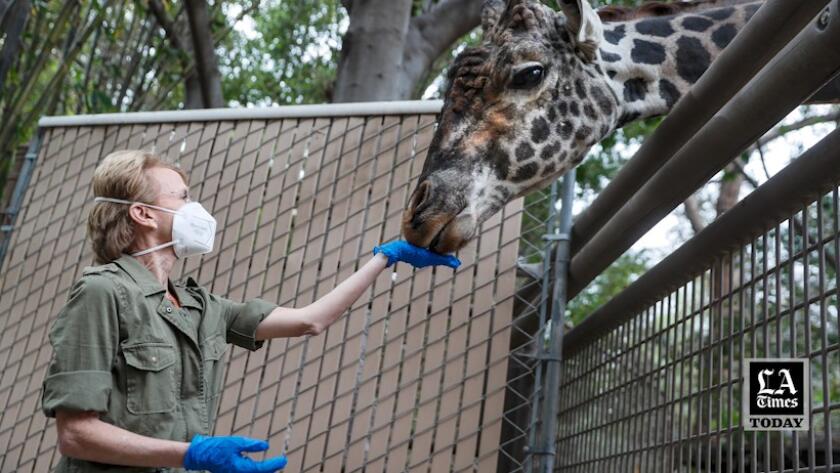Why this UCLA professor is studying female animals to gain insights into women’s health

Zainabu was in good health in the days before she gave birth to her fourth baby, despite the fact that her blood pressure was likely somewhere around 280/220.
For a human, such a reading would be catastrophic. Spiking blood pressure in a pregnant or recently postpartum woman is a sign of preeclampsia, a common but potentially fatal condition that can affect the heart, lungs, liver and kidneys.
Zainabu, fortunately, is a Masai giraffe at the Los Angeles Zoo. Giraffes have the highest known blood pressure in the animal kingdom, but this has no apparent effect on fetal or maternal health.
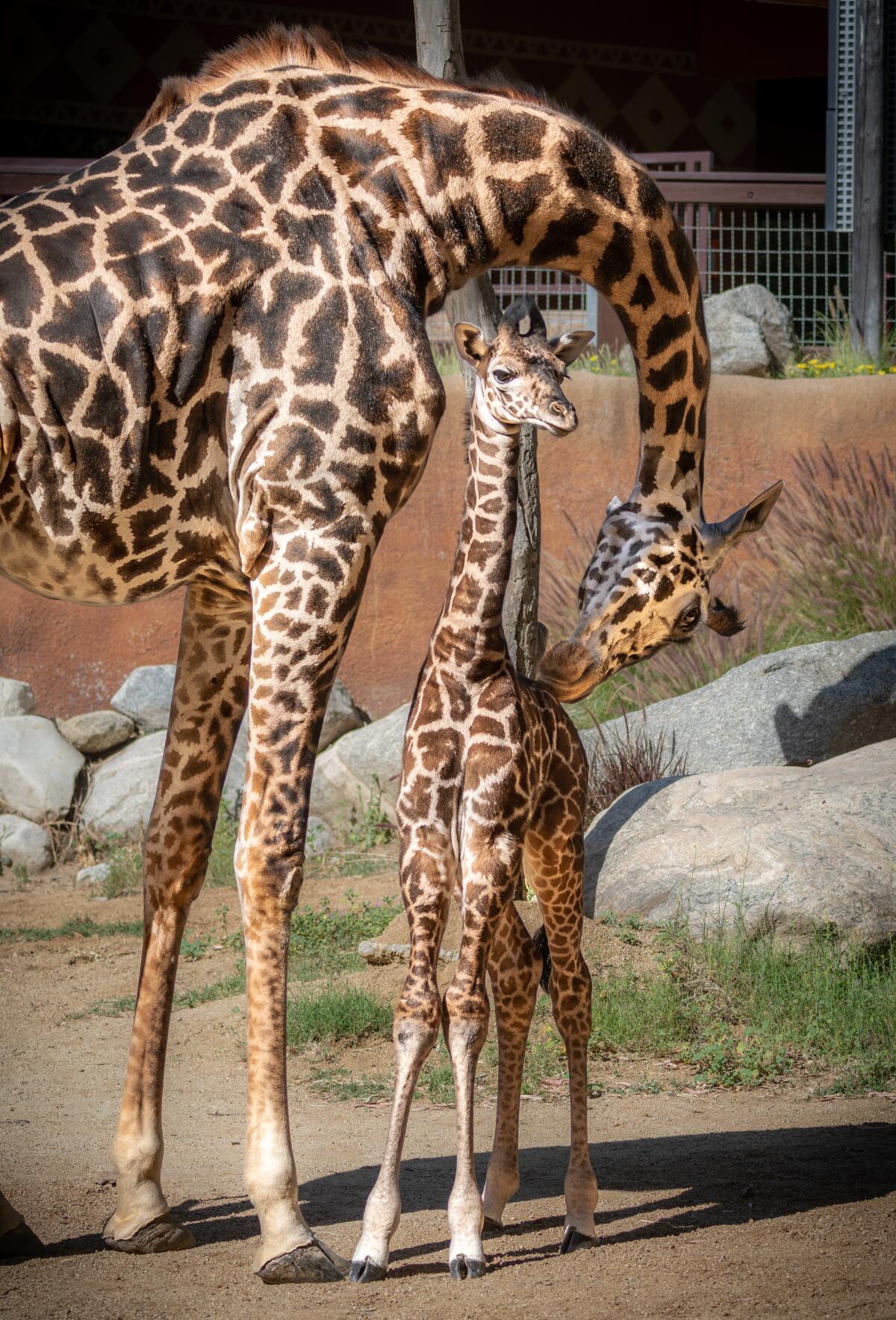
For Dr. Barbara Natterson-Horowitz, a UCLA cardiologist with a long-standing interest in cross-species health, this raises some compelling questions.
What adaptations have evolved in female giraffes that protect their cardiovascular systems from the damage high blood pressure can cause?
And why don’t we know enough about the physiology of human females to prevent a common complication like preeclampsia?
Natterson-Horowitz’s side gig treating animals at the L.A. Zoo has led her to explore health connections across species. She and collaborator Kathryn Bowers wrote the 2012 bestseller “Zoobiquity” about the intersection of human medicine, veterinary medicine and evolutionary biology, followed by 2019’s “Wildhood,” which examined adolescence across the animal kingdom.
Her latest focus is on cross-species similarities in female health, a field that has long been underfunded, understudied and misunderstood. Diseases that primarily affect women get a disproportionately small amount of research money relative to the years of healthy life they steal. (The reverse is true for diseases that primarily affect men.) In addition, women have historically been a minority of clinical trial participants, and for several years those of childbearing age were barred as research subjects in the U.S., a policy the National Institutes of Health reversed in 1986.
We can’t go back in time, Natterson-Horowitz says. But we can fill some of the gaps by looking to the animal world.
Many of the species that share our planet are exposed to similar stressors and environmental contaminants. Some endure the same chronic diseases that humans do, while others appear to be naturally resistant. Solutions to some of medicine’s most vexing questions could be walking on four feet beside us.
As cervical cancer screenings among Southern California women drop, experts sound the alarm about the ramifications of letting women’s wellness fall by the wayside.
“There’s a pretty vast landscape of unexamined assumptions about human uniqueness,” Natterson-Horowitz said. Failing to recognize our place in the animal kingdom, she added, “can prevent us from recognizing connections that, were we to see and understand them, could allow us to better understand the cause of disease and to be better at innovating effective solutions.”
Natterson-Horowitz grew up in Los Angeles as the daughter of two psychotherapists. She made occasional trips to the zoo as a child, with no inkling that some of the animals she was looking at would later become her patients.
She studied evolutionary biology at Harvard under famed biologists E.O. Wilson and Stephen Jay Gould. She returned to California for medical school at UC San Francisco and a residency and fellowship at UCLA.
She’d been on the faculty at UCLA for a decade when, in 2005, she got a call from the zoo asking for assistance with a transesophageal echocardiogram, a type of ultrasound exam she specialized in. This one would be for a chimpanzee, her first nonhuman patient.
It was a procedure she’d performed countless times before. But probing the internal biology of a fellow primate, albeit one that wasn’t human, was like “that gleam of light you see when you crack open a door,” she recalled: “In this case, the door happened to be separating my world of modern human medicine and the natural world’s endless health insights.”
Physicians tend to be human-centric in their approach. But veterinarians investigating perplexing problems often look to the medical histories of other species — including Homo sapiens.
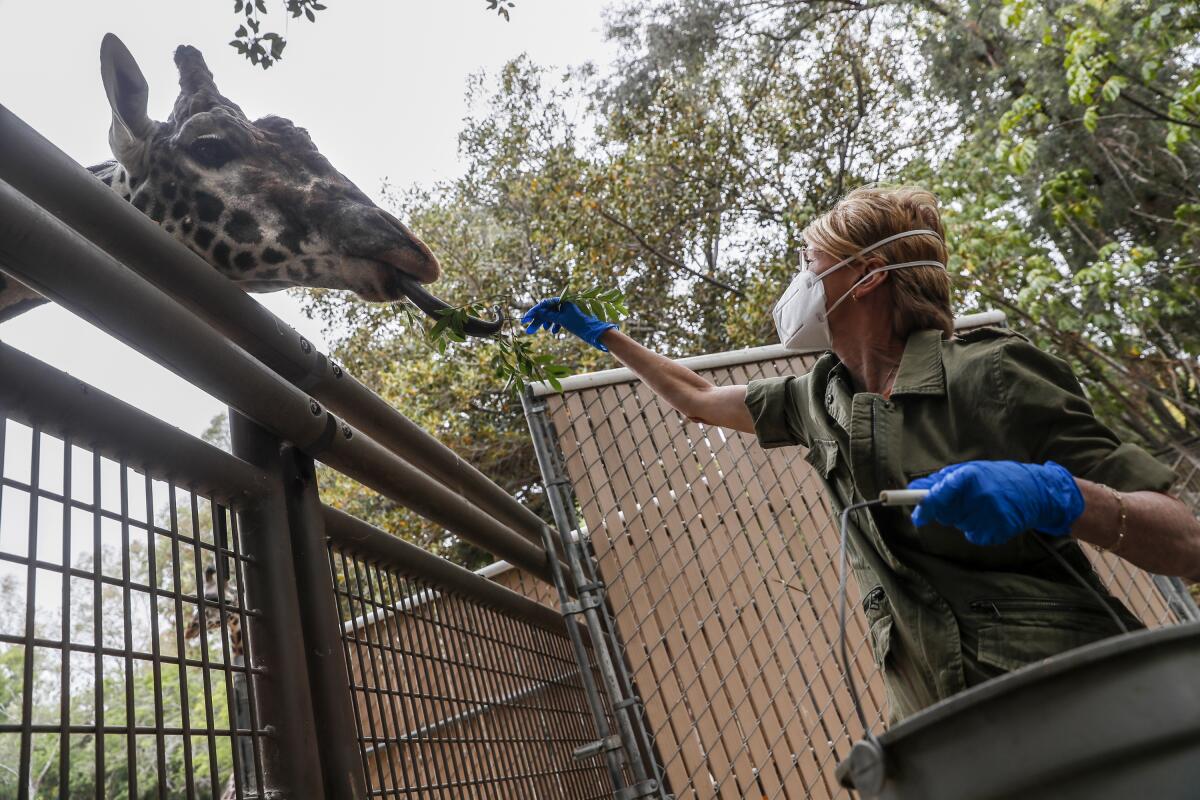
“We’ve always done that, because we know that there’s a lot more research that goes on in many of these diseases in humans,” said Jane Sykes, a professor of small animal internal medicine at the UC Davis School of Veterinary Medicine. “We’re always looking for parallels. ... Is there anything in humans that can help this dog in front of us?”
Now Natterson-Horowitz wanted to do the same thing, just in the other direction. The more she consulted with the L.A. Zoo, the more she came to admire that inclusive approach — and to question its absence in human medicine.
“Anthropocentrism is a blindfold,” she said of humans’ fixation on our own species. “If we can move beyond that, we could see connections that are meaningful and powerful.”
One of the first patients to spark her interest in female health was a lioness with pericardial effusion, or fluid in the sac around her heart. The condition affects at least 20% of cancer patients, both feline and human, and breast cancer is common in lions. Those two facts made veterinarians worry the lioness had an advanced case of the disease.
Natterson-Horowitz started researching. She knew that breast cancers in some women were connected to BRCA1, a gene on the 17th chromosome. People born with certain versions of the gene are more likely to develop breast cancer when exposed to an environmental or hormonal trigger.
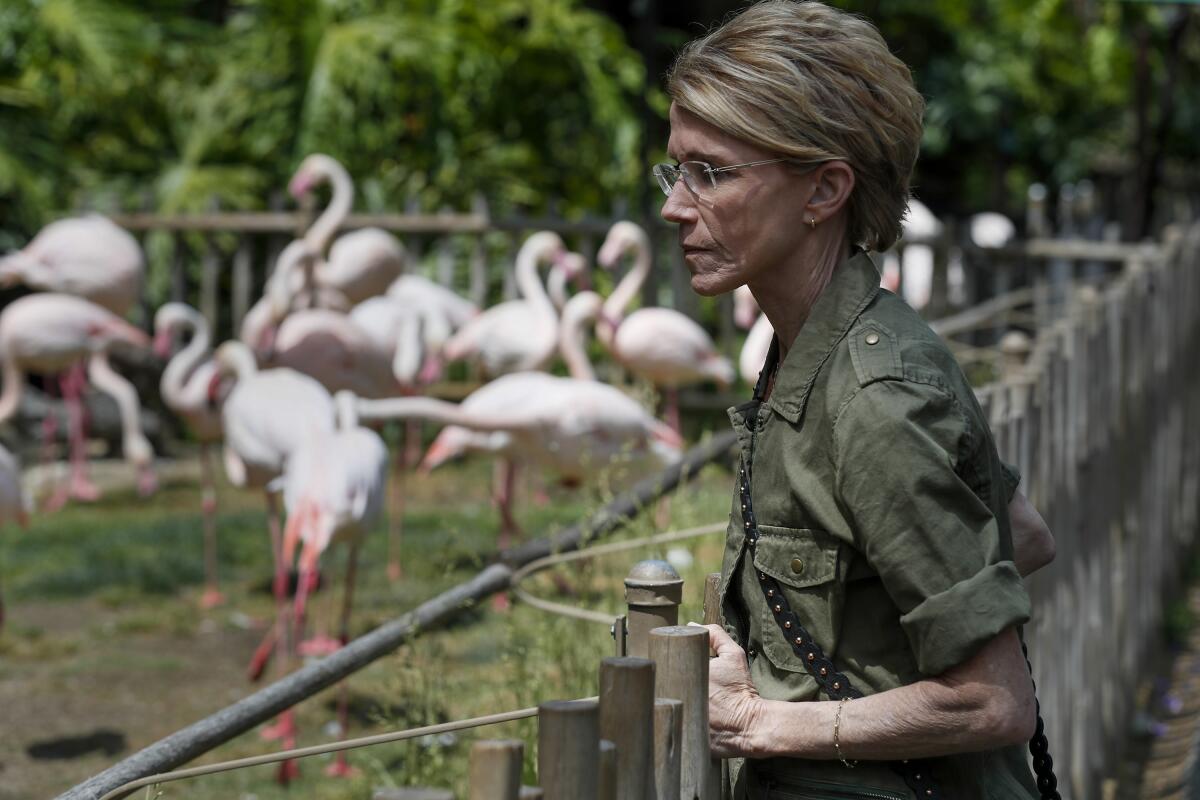
What she had not realized was how many non-primate species shared this vulnerability. English springer spaniels with certain BRCA1 variants were four times more likely to develop breast cancer than dogs with the most common version of the gene, Natterson-Horowitz noted in “Zoobiquity.” Another study found that zoo jaguars taking a particular type of hormonal birth control developed breast cancer in rates similar to human women with high-risk BRCA1 variants, and that the cancer was common in lions and other big cats.
Many factors influence breast cancer rates in females across the animal kingdom: age, genetics, the frequency and duration of lactation, environmental factors and hormonal changes.
Taken together, the range of mammals vulnerable to breast cancers could offer a trove of valuable comparative data, Natterson-Horowitz realized. But virtually no one was looking for it — even for a disease that claims the lives of more than 42,000 women in the U.S. alone each year.
So she started researching these evolutionary links herself. As she dug in, she said she noticed something else: “Not only is human medicine anthropocentric, it’s androcentric” — that is, focused on cisgender men.
Until the 1993 passage of the NIH Revitalization Act, women and people of color were not required to be part of research studies or clinical trials funded by the NIH, and as a result they usually weren’t. The same preference for males is even seen in research on mice. In 2016, NIH set a new policy requiring researchers to at least “consider” biological sex as a variable in the design of human cell and animal studies, though they can study one only sex if they can show “strong justification” for it.
“The good news is that today, over half of the participants in NIH clinical trials are women,” said Dr. Janine Austin Clayton, director of the NIH Office of Research on Women’s Health. But, she noted, women are still underrepresented in studies of several major diseases, including cardiovascular disease, kidney disease, hepatitis and HIV/AIDS.
“Until we have representation across every disease category that affects women and men,” she said, “we still have work to do.”
A male-centered research approach manifests in many ways. It isn’t just the dearth of funding for conditions primarily affecting women, like endometriosis and rheumatoid arthritis. It’s that data on female bodies are often absent from medical research altogether, resulting in skewed results that can shortchange all genders.
During a recent and engaging presentation for patients on Medicare, I received a pamphlet listing crucial tests for people of a certain age.
The result is that researchers often haven’t even realized when their results apply only to men.
Take heart attacks. When the Physicians’ Health Study, whose sample consisted of 22,071 men and zero women, found in 1989 that a low regular dose of aspirin led to a 44% decrease in heart attacks, many physicians recommended the treatment to men and women alike.
But the 39,876 participants in the Women’s Health Study allowed researchers to report in 2005 that for women younger than 65, aspirin didn’t help at all. And for those 65 and older, aspirin prevented not only heart attacks but strokes — a benefit that was not apparent in the all-male study and would have remained unseen without studying women.
Excluding women from research studies forces doctors to treat them “as guinea pigs, generation after generation after generation,” said Chloe Bird, a sociologist who heads the Center for Health Equity Research at Tufts Medical Center in Boston.
For the record:
1:22 p.m. Oct. 14, 2022An earlier version of this article reported that the Center for Health Equity Research was at Tufts University. It is based at Tufts Medical Center, which is not part of the university.
Bird has not been involved in Natterson-Horowitz’s efforts to take a broader look at the female population of the animal kingdom, which she called “fantastic, and so needed.”
“There is a tremendous opportunity to look across species, and begin to understand ... what happens with what systems and why, and how we could improve healthcare,” Bird said.
A long-standing tradition of keeping pregnant women out of clinical trials is having serious consequences with regard to COVID-19.
Natterson-Horowitz is now leading a team of obstetrician/gynecologists, wildlife veterinarians and veterinary pathologists to study giraffe pregnancy to understand why animals like Zainabu — who delivered a healthy, 172-pound calf in April — are not vulnerable to the cardiovascular crises that strike pregnant humans. She’s also working with dairy veterinarians to better understand mastitis, a common but painful inflammation of breast tissue, to come up with improved treatments and design a better breast pump for women.
But Natterson-Horowitz knows unlocking the secrets of the animal world is not a one-person job. Since 2011 she has organized Zoobiquity conferences that have brought together thousands of physicians, veterinarians and evolutionary biologists to examine health issues from multispecies perspectives. The most recent, titled “Female Health Across the Tree of Life,” took place in July in Lisbon, Portugal.
She also teaches the relevance of the animal world to undergraduates and medical students at UCLA and Harvard, and is heartened to see the eagerness of a new generation of physicians to look across species for answers.
Climate change and urbanization have blurred the boundaries between the human and nonhuman animal worlds, Natterson-Horowitz pointed out. Zoonotic diseases like COVID-19 and influenza have shown us how closely we’re tied to fellow members of the animal kingdom.
When she first got into medicine, she pledged to do no harm. Today, she believes, “If we can move from an androcentric, anthropocentric view to a sex-, gender-, and species-spanning perspective, then we can do good.”
Watch L.A. Times Today at 7 p.m. on Spectrum News 1 on Channel 1 or live stream on the Spectrum News App. Palos Verdes Peninsula and Orange County viewers can watch on Cox Systems on channel 99.

